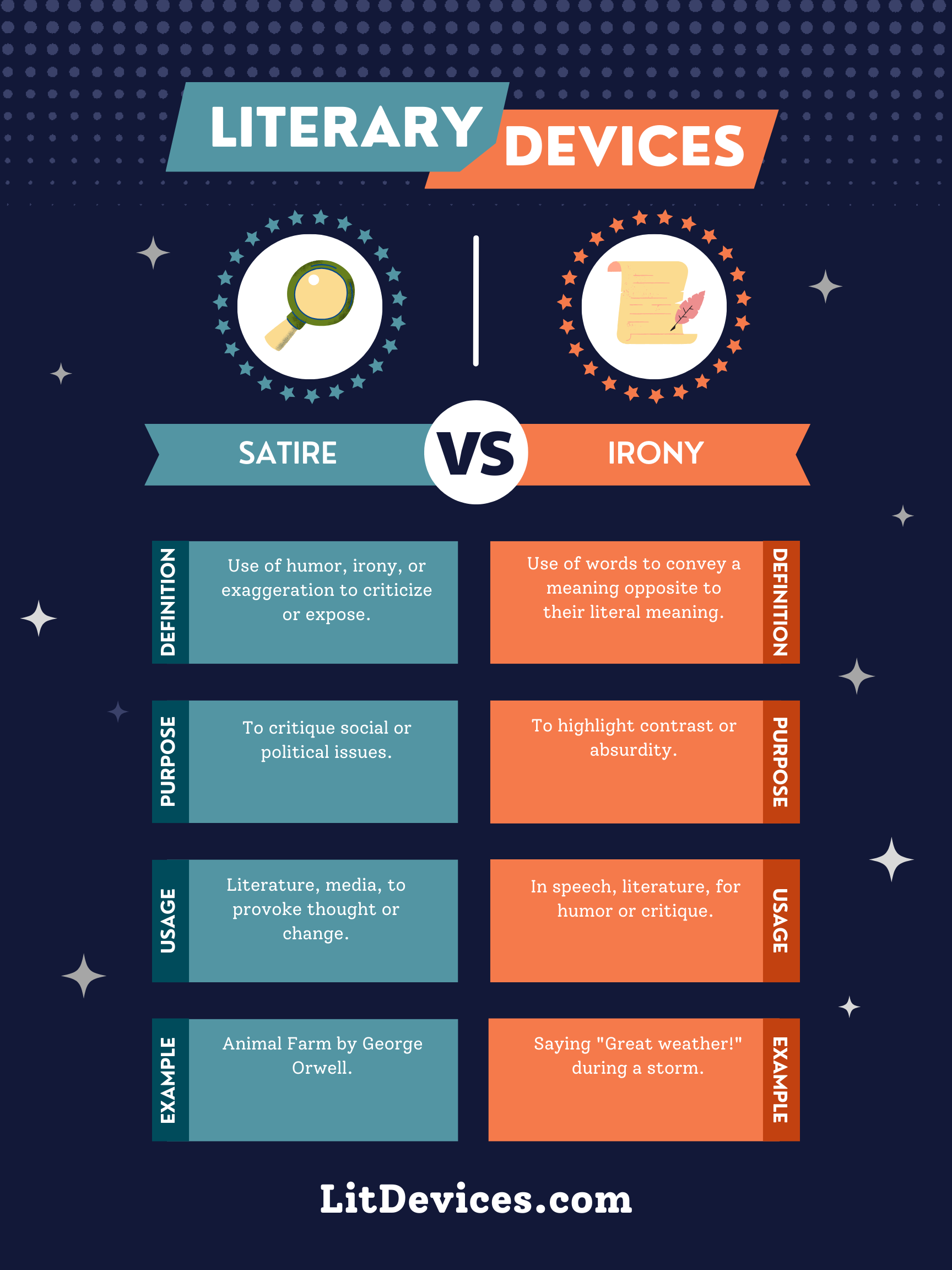Satire uses humor, irony, or exaggeration to criticize or mock; Irony involves saying the opposite of what is meant or expected.
Satire and irony are two literary devices that enrich texts with humor, critique, and thought-provoking commentary. Both are used to convey messages in a way that is both engaging and enlightening, often leaving a lasting impression on the audience. Let’s dive into each device, exploring their nuances and how they’re employed in literature. 😄🔄
Satire
Satire is a literary device used to expose and criticize foolishness or corruption of an individual or a society, using humor, irony, exaggeration, or ridicule. It intends to improve humanity by criticizing its follies and foibles. A famous example of satire is Jonathan Swift’s “A Modest Proposal,” where he suggests that the solution to poverty in Ireland is for the poor to sell their children as food to the rich, thereby mocking the heartless attitudes towards the poor.
Irony
Irony, on the other hand, is a figure of speech in which words are used in such a way that their intended meaning is different from the actual meaning of the words. It may also be a situation that ends up in quite a different way than what is generally anticipated. A classic example is O. Henry’s “The Gift of the Magi,” where a young couple sell their most prized possessions to buy each other Christmas gifts, only to find the gifts are now useless, highlighting the ironic outcome of their sacrifices.
Summary
| Literary Device | Definition | Purpose | Usage | Relevant Examples |
|---|---|---|---|---|
| Satire | Uses humor, irony, or exaggeration to criticize or mock. | To expose and critique societal or individual flaws. | Literature, cartoons, articles. | “A Modest Proposal” by Jonathan Swift. |
| Irony | Saying the opposite of what is meant, leading to an unexpected outcome. | To highlight discrepancies between expectations and reality. | Stories, speeches, everyday conversation. | “The Gift of the Magi” by O. Henry. |
Writing Tips
When writing satire or irony, consider the following tips:
- Know Your Audience: Ensure your audience will understand and appreciate the irony or satire. Cultural and contextual knowledge can greatly affect interpretation.
- Balance is Key: For satire, balance humor with critique to avoid sounding too bitter. For irony, subtle hints can make the revelation more impactful.
- Use Real-Life Inspiration: Drawing from current events or personal experiences can make satire more relatable and irony more believable.
- Practice Subtlety: Both satire and irony benefit from subtlety. Over-explaining can spoil the effect.
FAQs
How do satire and irony differ in purpose?
Satire aims to critique and possibly improve societal flaws through humor and critique, while irony highlights the discrepancy between expectations and reality, often for dramatic or humorous effect.
Can satire include irony?
Yes, satire often uses irony as one of its tools to critique and mock.
Is irony always humorous?
No, irony can also be tragic or dramatic, depending on the context and the way it’s used.
Exercise
Read the following sentence and identify whether it’s an example of satire or irony:
“The city’s plan to reduce water waste by promoting the use of disposable plastic bottles was praised as a brilliant solution.”
Answer: This sentence is an example of satire, as it mocks the idea of solving one environmental issue with a solution that exacerbates another.
Other Interesting Literary Device Comparisons
- Metaphor vs. Simile: Both compare two things, but metaphors do so directly, while similes use “like” or “as.”
- Alliteration vs. Assonance: Alliteration repeats consonant sounds at the beginning of words, while assonance involves the repetition of vowel sounds within words.
- Hyperbole vs. Understatement: Both exaggerate for effect, but hyperbole does so through overstatement, while understatement downplays the actual situation.
Exploring these devices can further enrich your understanding and appreciation of literary craftsmanship. 📚✍️

